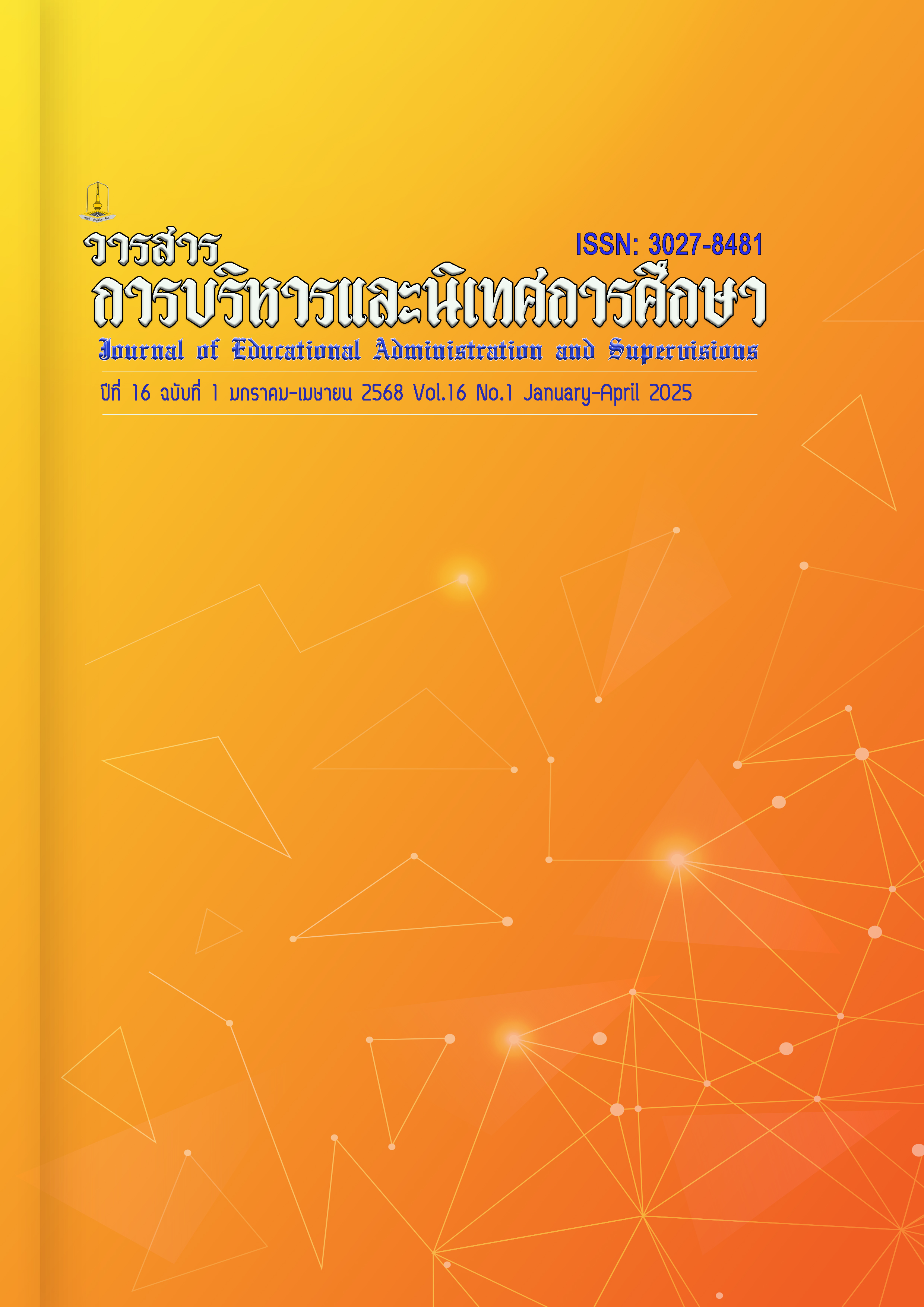The Development of Indicators on the Generational Diversity Management among Personnel under the Chaiyaphum Primary Educational Service Area Office 1
Main Article Content
Abstract
The objectives of this research were 1) to examine the components and indicators of generational diversity management among personnel in educational institutions and 2) to conduct a confirmatory factor analysis of generational diversity management among personnel under the Chaiyaphum Primary Educational Service Area Office 1. The total population consisted of 2,117 individuals, with a sample size of 500 participants, determined using a 10:1 ratio for 50 parameters. The sample was obtained through a multistage random sampling technique. A quantitative research methodology was employed to derive confirmatory components. The data collection instrument utilized was a five-point Likert scale questionnaire. Data analysis was conducted using second-order confirmatory factor analysis (CFA).
The findings revealed that 1) the components and indicators of generational diversity management among personnel in educational institutions under the Chaiyaphum Primary Educational Service Area Office 1 comprised 5 main components (1) team building development, (2) coaching training and mentoring, (3) work environment enhancement, (4) staff development program, and (5) equal opportunity and equity. 2) The confirmatory factor analysis results indicated that the model for generational diversity management among personnel in educational institutions was consistent with the empirical data with χ^2= 91.560, df = 76, P-Value = 0.108, CFI = 0.997, TLI = 0.996, GFI = 0.977, AGFI = 0.959, RMSEA = 0.020.
Downloads
Article Details

This work is licensed under a Creative Commons Attribution-NonCommercial-NoDerivatives 4.0 International License.
References
จีราพร นักปราชญ์. (2559). การบริหารความหลากหลายของบุคลากรในโรงเรียน สังกัดสำนักงานเขตพื้นที่การศึกษามัธยมศึกษา เขต 25 [การค้นคว้าอิสระปริญญามหาบัณฑิต, มหาวิทยาลัยขอนแก่น]. https://kkuir.kku.ac.th/jspui/handle/123456789/29888
เจนจิรา เทียนวิจิตร. (2564). แรงจูงใจในการทำงานและสภาพแวดล้อมในการทำงานที่มีความสัมพันธ์ต่อ พฤติกรรมเชิงสร้างสรรค์ในการทำงานของกลุ่มคน Generation Y ในเขตกรุงเทพมหานคร [สารนิพนธ์ ปริญญามหาบัณฑิต, มหาวิทยาลัยศรีนครินทรวิโรฒ].
ชาญชัย ชัยสุขโกศล, อัจฉรีย์ อำไพกิจพาณิชย์, นริศ มณีขาว และรุจิรัตน์ ดุรงค์วิริยะ. (2565). การศึกษาและพัฒนาการสื่อสารด้วยความเข้าใจระหว่างคนต่างรุ่นในองค์กร. ศูนย์คุณธรรม (องค์การมหาชน).
ชูชัย สมิทธิไกร, และ ภัทรานิษฐ์ โชติพิพิทย์กุล. (2564). อิทธิพลของการจัดการความหลากหลายด้านช่วงอายุที่มีต่อความผูกพันต่อองค์การของพนักงานเจเนอเรชันวาย: แบบจําลองการสื่ออิทธิพลที่มีตัวแปรกํากับ. วารสารการพัฒนาทรัพยากรมนุษย์และองค์การ, 13(1), 81-111. https://so01.tci-thaijo.org/index.php/HRODJ/article/view/242982
ณัฐชญา เพ็งธรรม. (2565). โมเดลสมการการจัดการความหลากหลายทางเจเนอเรชันที่ส่งผลต่อประสิทธิผลการปฏิบัติงานของครูในโรงเรียน สังกัดสํานักงานเขตพื้นที่การศึกษาประถมศึกษาขอนแก่น เขต 4 [วิทยานิพนธ์ปริญญามหาบัณฑิต, มหาวิทยาลัยขอนแก่น]. https://kkuir.kku.ac.th/jspui/handle/123456789/37526
ณิชกุล เสนาวงษ์. (2564). การศึกษาพฤติกรรมการใช้สื่อสังคมออนไลน์ของคนเจนเนอเรชั่นแซดในยุค New Normal ในกรุงเทพมหานคร [การค้นคว้าอิสระปริญญามหาบัณฑิต, มหาวิทยาลัยสยาม]. https://e-research.siam.edu/kb/a-study-of-behavior-for-using-of-social-media/#
ทวีป มหาสิงห์. (2563). การก่อรูป "ทฤษฎีความยุติธรรม" ของจอห์น รอลส์. วารสารรัฐศาสตร์และรัฐประศาสน-ศาสตร์, 11(พิเศษ), 1-28. https://so05.tcithaijo.org/index.php/polscicmujournal/article/download/240902/168304
พงศ์พิษณุ ตางจงราช. (2564). รูปแบบการบริหารจัดการความหลากหลายทางเจเนอเรชันของบุคลากรในโรงเรียน สังกัดสำนักงานเขตพื้นที่การศึกษาประถมศึกษาอุดรธานี เขต 2 [วิทยานิพนธ์ปริญญามหาบัณฑิต, มหาวิทยาลัยขอนแก่น]. https://kkuir.kku.ac.th/jspui/handle/123456789/37659
พัฒนกร ปานฑสูตร. (2563). การจัดการความหลากหลายของบุคลากรในโรงเรียนมัธยมศึกษา [วิทยานิพนธ์ปรัชญาดุษฎีบัณฑิต, มหาวิทยาลัยศิลปากร]. https://sure.su.ac.th/xmlui/bitstream/handle/123456789/24503/DR_พัฒนกร_ปานฑสูตร
พิมลพรรณ เพชรสมบัติ. (2564). ผู้บริหารกับการทำงานเป็นทีม. วารสารครุศาสตร์ คณะครุศาสตร์ มหาวิทยาลัยราชภัฏนครสวรรค์, 4(1), 1–7. https://so02.tcithaijo.org/index.php/edunsrujo/article/view/253748
ยุทธศักดิ์ อินทฤๅกูร สวัสดิ์วงศ์ชัย, พรเทพ เสถียรนพเก้า และวัลนิกา ฉลากบาง. (2565). การพัฒนารูปแบบการทำงานเป็นทีมที่ส่งผลต่อประสิทธิผลของโรงเรียนมัธยมศึกษาในภาคตะวันออกเฉียงเหนือ. วารสารสังคมศาสตร์เพื่อการพัฒนาท้องถิ่น มหาวิทยาลัยราชภัฏมหาสารคาม, 6(3), 10–25. https://so02.tci-thaijo.org/index.php/soc-rmu/article/view/254181
Akpapuna, M., Choi, J., Johnson, R., & Lopez, A. (2020). Encouraging multiculturalism and diversity within organizational behavior management. Journal of Organizational Behavior Management, 40(3–4), 186–209. https://doi.org/10.1080/01608061.2020.1832014
Bentler, P. M., & Chou, C. P. (1987). Practical issues in structural modeling. Sociological Methods & Research, 16(1), 78–117. https://doi.org/10.1177/0049124187016001004
Cronbach, L. J. (1984). Essentials of psychological testing. (4th ed). Harper & Row.
Eby, L. T., Allen, T. D., Evans, S. C., Ng, T., & Dubois, D. (2008). Does mentoring matter? A multidisciplinary meta-analysis comparing mentored and non-mentored individuals. Journal of Vocational Behavior, 72(2), 254–267. https://doi.org/10.1016/j.jvb.2007.04.005
Jones, G., Chirino Chace, B., & Wright, J. (2020). Cultural diversity drives innovation: Empowering teams for success. International Journal of Innovation Science, 12(3), 323–343. https://doi.org/10.1108/IJIS-04-2020-0042
McShane, S. L., & Von Glinow, M. A. (2018). Organizational behavior: Emerging knowledge global reality. (8th ed). McGraw-Hill Education.
Rudolph, C. W., Rauvola, R. S., Costanza, D. P., & Zacher, H. (2021). Generations and generational differences: Debunking myths in organizational science and practice and paving new paths forward. Journal of Business and Psychology, 36(1), 945-967. https://doi.org/10.1007/s10869-020-09715-2
Schumacker, R. E., & Lomax, R. G. (2016). A beginner's guide to structural equation modeling. (4th ed). Lawrence Erlbaum Associates.
Verasamy, N., Abdul Majid, A. H., & Jamaluddin, N. A. (2020). Generational diversity, personal attributes and organizational commitment among employees of corporate consultants. Journal of Management and Entrepreneurship, 22(1), 65-72. https://doi.org/10.9744/jmk.22.1.65-72


